A case study from Staffs and Warks, March 2014: conflicting morphology and vocalisations
|
A case study from Staffs and Warks, March 2014: conflicting morphology and vocalisations |
Abstract
The winter of 2013/2014 witnessed a series of Chiffchaffs Phylloscopus collybita ssp. with plumage features associated with Siberian Chiffchaff but calling persistently as Common Chiffchaff (abietinus/collybita). The first was at Öland, Sweden, in mid-October 2013, and was followed between November 2013 and March 2014 by six individuals in central and southern England. All seven were thoroughly documented and their calls sound-recorded. A further four were reported but not sound-recorded. Taken in isolation, their calls would be equated with Common Chiffchaffs yet their plumage clearly exhibited characters associated with Siberian Chiffchaffs. These individuals demonstrate that, contrary to some assertions, call alone does not unfailingly distinguish between Siberian and Common Chiffchaffs and neither does call override in importance a careful examination of plumage. Clearly, some individuals exhibit an apparent conflict between plumage and call. Although calls were not determined, anomalous song has been associated with hybrids - see Shipilina et al. (2017). While 'learning' (copying from parent) is considered to play a significant role in song development, call is considered to have a more strongly innate (i.e. genetic) foundation. While this would not necessarily preclude one taxon occasionally uttering the call of the other, an individual (yet alone a series of individuals) persistently employing the call of another taxon is clearly abnormal and implies something profoundly amiss with the normal processes of call development. Compounding their enigmatic vocalisations, three individuals began to sing as the Spring approached and proved to be 'mixed singers', with individual song-phrases incorporating notes from the repertoires of both Siberian Chiffchaff and Common Chiffchaff. Outside the overlap zone between tristis and abietinus in the Urals and Archangelsk region, Siberian Chiffchaff and Common Chiffchaff are reportedly indifferent to each other's songs (Martens & Meincke, 1989). Only in the region of sympatry do they react to each other's songs, with 'mixed singers' encountered (Marova et al., 1993, 2008, 2013; Lindholm, 2008). Based upon the mismatched morphology and song of Chiffchaffs in their studies, Marova et al. and Lindholm concluded that hybridization between tristis and abietinus was involved. More recently, 'whole genome sequence data' (Shipilina et al. 2017) has confirmed that the two taxa hybridize in the region of sympatry and that plumage and song anomalies are the result of genetic admixture (see main text). By extension, the enigmatic Chiffchaffs reported from Sweden and England share the hallmarks of the Chiffchaffs in the studies in the Urals by Marova et al. and Shipilina et al., with evident conflicts between vocalisations and appearance. Whether by hybridisation or by 'copying', the use of abietinus-style vocalisations by individuals with tristis-like plumage points to an origin in the region of sympatry. The occurrence in western Europe during a single winter of a cluster of such enigmatic individuals, and their likely origin in the zone of sympatry and hybridisation, suggest that identification criteria for tristis should remain robust, founded on the traditional identification criteria and expanded only to accommodate individuals with the most rudimentary 'fulvescens' traits. Careful examination of both plumage and vocalisations is essential in diagnosis. Photographs and sound-recordings of anomalous vocalists in Staffs and Warks are presented below.
On October 17th, 2013, at Öland, Sweden, Magnus Hellström observed, photographed and sound-recorded a Chiffchaff with an appearance which he equated with ‘fulvescens’ yet giving a confident, consistent and prolonged series of abietinus/collybita calls (a rising ‘hüit’).
See: Öland Chiffchaff
Following discussions on the internet (including Martin Garner's much-missed 'Birding Frontiers') other reports emerged of Chiffchaffs with a conflict between morphology and call, while I have received details of others subsequently. Between November 2013 and March 2014, individuals in England were thoroughly documented and calls sound-recorded in Bedfordshire, Devon (2), Staffordshire and Warwickshire (2), with others reported from Cheshire, London, Warwickshire and Worcestershire. Three individuals (Bedford, Warks & Worcs) also proved to be 'mixed singers'.
Six of the anomalous callers were photographed and/or video'd and were also sound-recorded, thus putting their combination of plumage and call beyond question. Video & calls of one of the birds in Devon and photographs & calls of the bird in Bedfordshire can be examined here:
Devon (Mike Langman)
Bedford (Steve Blain)
I was able to sound-record three which were within my 'home territory' of the west Midlands (in Staffs and Warks, respectively).
The Staffs individual was particularly obliging and images appear in Plates 1 and 2 below:
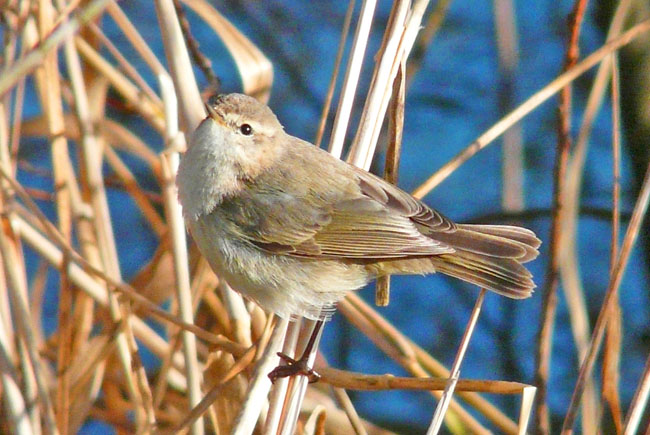
© A. R. Dean
Plate 1. Chiffchaff with apparent conflict between appearance and call. Alrewas, Staffs, March 2014
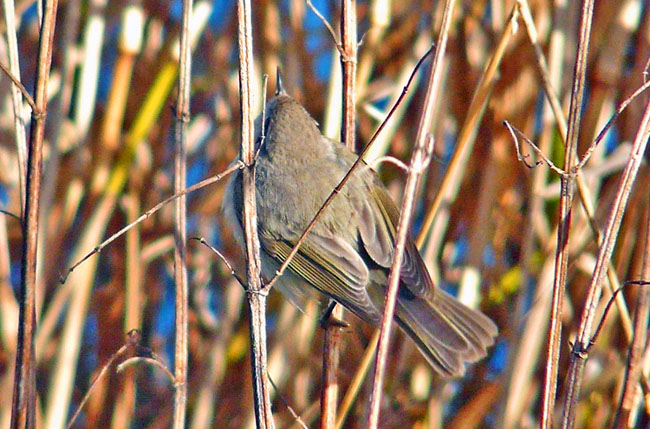
© A. R. Dean
Plate 2. Chiffchaff with apparent conflict between appearance and call. Alrewas, Staffs, March 2014
Like those encountered at Ӧland, Devon and Bedford, this individual matched the 'Siberian Chiffchaff' phenotype well, though a little less buff below and with more-conspicuously olive edges to the remiges and rectrices than individuals from east of the Yenisey. It called frequently and consistently and the call was a perfect match with the rising 'huit' call of collybita/abietinus. A recording of the call is here ►.
A sonogram of the call appears in Figure 1, where it is compared with the call of a collybita recorded in the West Midlands in April 2011.
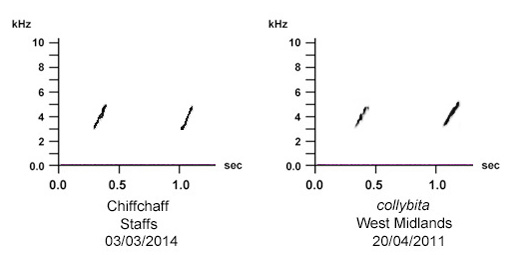
Fig. 1. Call of Chiffchaff in plates 1 & 2 compared with call of nominate collybita
The Warks bird at Hartshill (plate 3) also exhibited plumage traits associated with 'Siberian Chiffchaff' though buff hues were more subdued compared with the Staffs individual and there was perhaps a slight olive tinge to the mantle. Two such individuals were reported from this site earlier in the month. Were it not for their calls, both the Staffs and Warks individuals would no doubt be equated readily with tristis (or at least 'fulvescens') by most observers.
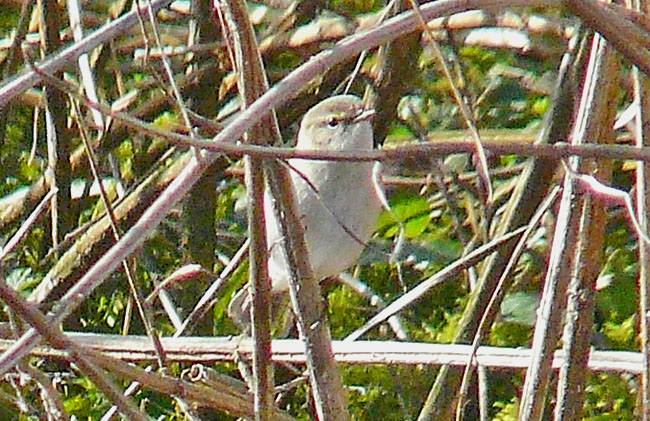
© A. R. Dean
Plate 3. A second Chiffchaff with apparent conflict between appearance and call. Hartshill, Warks, March 2014
That six such anomalous callers should be sound-recorded (and several others reported) in a single winter is certainly intriguing and upsets radically the often-stated philosophy that calls are a failsafe guide to identity which overrides the need for painstaking evaluation of plumage. Taken in isolation, the calls of the individuals described here would suggest that they were Common Chiffchaffs yet their plumage clearly exhibited the characters of tristis / 'fulvescens'. Whatever the origins of these perplexing individuals, it is now beyond question that calls are not a bilateral and infallible guide and that identification requires careful analysis of both vocalisations and appearance. What are the possible origins of such individuals? There seem to be at least three possibilities:
Two points are worth noting initially. Firstly, the recorded calls are not isolated, hesitant, 'plastic' calls, as can be heard from young juveniles when first practising their calls (see discussion here). They are fully-crystallized calls, delivered confidently and persistently. Secondly, unlike song (which is deemed to be primarily 'learned' or 'copied'), call in oscine passerines is deemed to be innate, though it still needs to be perfected by practice in its earliest stages. While this would not preclude a Siberian Chiffchaff from uttering the occasional Common Chiffchaff call (whether by design or accident) it would imply a profound disruption of normal call development for an individual (yet alone a series of individuals) to abandon a genetically programmed call completely and supplant it with a call 'copied' from another taxon.
However, if it were to be assumed for the moment that these calls have been 'copied' from Common Chiffchaffs, then how and where has this come about? In order to encounter and be influenced by a chorus of Common Chiffchaff calls on and around the breeding grounds (Option 1), it would imply that such individuals have originated from the region of sympatry between Common Chiffchaff (abietinus) and Siberian Chiffchaff in the Urals region (where hybridization has been confirmed e.g. Shipilina et al 2017) . Further east, Siberian Chiffchaffs will not encounter abietinus and there will be no cultural or competitive recognition. It is worth noting that it is only in the region of sympatry that Siberian and Common Chiffchaffs react to each other's songs (e.g. Marova et al 2013). Further east tristis does not respond at all to abietinus song. Thus, it seems that only in the region of sympatry are there 'vocal interactions' between the two taxa (see also 'mixed singers' described below).
What of Option 2? Would a Siberian Chiffchaff originating east of the Urals, and having perfected its innate call, then abandon it and copy the call of Common Chiffchaff when encountering nominate collybita on the wintering grounds? That hardly seems credible for individuals originating east of the region of sympatry (with no prior 'competetive' or any other interaction with collybita/abietinus). What would be the 'driving force' for such an unnatural abandonment of the genetically-primed call? Also, not all individuals with anomalous calls have been in areas hosting nominate collybita (indeed, some have been 'isolated' individuals encountered at relatively remote migration points e.g. the individual in 2013 at Öland, while at some sites in Devon tristis have outnumbered collybita - per Mike Langman). Finally, the occurrence in a relatively short time-frame of a series of at least seven anomalous callers suggests a common 'background' of some sort.
Option 3 (hybridization) is discussed elsewhere on this site. Hybridization has been confirmed in the sympatric zone and song anomalies (as well as intermediate appearance) have been associated with hybrids. Clearly, hybridization could lead also to an apparent conflict between plumage and call. Several Chiffchaffs exhibiting an apparent plumage/call 'mismatch' during 2013/2014 also exhibited 'fulvescens' traits to one extent or another.
The findings of Shipilina et al. must signal caution in the identification of individuals with an apparent conflict between plumage and call, even those which apparently match well with the plumage criteria for tristis. Full details should be placed on record for the purposes of on-going research into these issues.
In March 2014 it emerged that vocal anomalies among wintering 'Siberian Chiffchaff types' were not confined to call but extended to song, with individuals exhibiting 'mixed song' and 'song switching' coming to attention. The Bedfordshire bird referenced above began to sing and, although its song was predominantly as tristis, sonograms revealed the presence of some abietinus/collybita-style notes. An individual sound-recorded in Worcestershire by Andy Warr also proved to be a 'mixed singer'. The song exhibited a degree of hesitancy ('plasticity') which suggests a young individual still developing its song. (Common Chiffchaff calls were also found subsequently in the recording but could not be unequivocally attributed to the same individual; however, other observers also reported hearing abietinus/collybita calls from this 'mixed singer'.)
Then a new individual was discovered in Warwickshire by David Hutton which proved to be a very radical 'mixed singer' and even a 'song switcher' and with fully crystallized and confidently delivered vocalisations.
Its standard call was once again the characteristic rising 'huit' of abietinus/collybita. A recording of the call is here ► while a sonogram appears in Figure 2.

Fig. 2. Call of 'mixed singing' Chiffchaff, Coton Lakes, Warks, March 2014. The call matches the standard rising 'huit' of abietinus/collybita (c.f. Fig. 1.)
Additionally, an alternative 'sweeoo' call was given occasionally. Although tristis too may use a 'sweeoo' call, this has only a shallow inflexion (a shallow arch) while the deep inflexion revealed by a sonogram of the Coton individual once more matches abietinus/collybita. A recording is here ►. The call is rather quiet but one benefit of this is that it demonstrates usefully how an abietinus/collybita 'sweeoo' call, when heard quietly or distantly, can easily suggest the standard call of tristis (largely because, although inflected, such 'sweeoo' calls are quite abrupt and start and finish on a similar frequency). The sonogram in Figure 3 captures the true structure well (see main text discussion of calls).
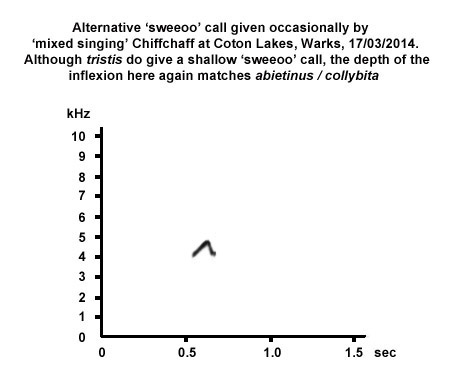
Fig. 3
The song provided a very marked example of 'mixed singing'. As well as individual phrases containing notes from the repertoires of both Siberian Chiffchaff and Common Chiffchaff, there were also some continuous sequences of abietinus/collybita notes followed by continuous sequences of tristis notes (i.e. 'song switching'). I obtained a series of recordings which captured all these variations.
A prolonged sequence of song which illustrates the variability and evident 'mixed singing' can be heard here ►.
Figure 4 shows a sequence which begins with six abietinus/collybita notes and then 'switches' to tristis notes.

Fig. 4. A sequence of six abietinus/collybita notes followed by tristis notes.
A sequence of tristis notes interrupted by a four-note sequence of abietinus/collybita notes can be heard here ►. A sonogram of this phrase appears in Figure 5.
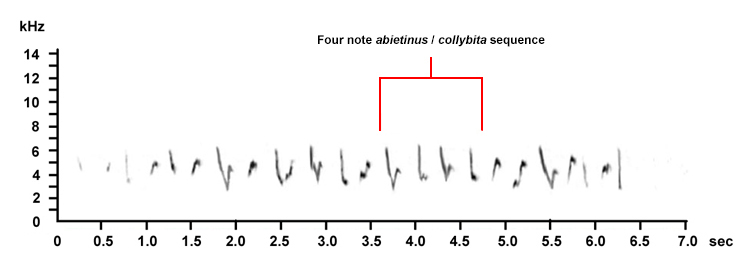
Fig. 5.
'Mixed singing' Chiffchaff :
tristis-style notes predominate but a four-note abietinus/collybita
style 'chiff-chaff-chiff-chaff' sequence is indicated in red.
The four consecutive abietinus/collybita notes extracted from this song-phrase can be heard separately here ►. Isolated 'chiff' style notes like the first of these four notes can be found occasionally in apparently 'good' tristis song but not 'chiff-chaff' pairs or sequences of such pairs, when they become very evident to the unaided ear.
This individual was decidedly 'grey' but appeared rather bleached and was also in moult. Thus, its appearance may not have been representative. However, it also showed pronounced olive on the rump and lower back, more so than might be expected even in 'fulvescens'.
Some ‘mixed singers’, with songs consisting of predominantly tristis notes but occasional interspersed abietinus notes, will sound very like mainstream tristis to the human ear (the more striking and varied tristis-style notes tend to ‘capture the ear’). Thus, such individuals can go undetected and there may well have been other ‘mixed singers’ in the UK but not revealed by recordings and sonogram analysis.
Given the increasing taxonomic significance which is attached to vocalisations, a combination of abietinus/collybita call and 'mixed song' raises inevitable questions. The clear implication is that such Chiffchaffs originate from the zone of sympatry and hybridization between tristis and abietinus in the Urals and Archangelsk region (Shipilina et al. 2017). They exemplify the provisos over Siberian Chiffchaff identification discussed elsewhere on this website and in items in British Birds (see References). They confirm that unqualified designation as 'Siberian Chiffchaff' requires very careful and thorough appraisal of both plumage and vocalisations (and even then there may be a small margin of error). Following the publication of de Knijff et al.(2012) there were suggestions that identification criteria for tristis should be relaxed but these anomalous vocalists together with the latest genetic research by Shipilina et al (op cit) indicate that assessment of tristis should remain guided by the traditional identification criteria, expanded only to accommodate individuals with the most rudimentary 'fulvescens' traits (see criteria adopted by BBRC 'tristis panel'). See also van der Spek & de Knijff (2021), where a second ringing and genetic study demonstrated the importance of well-founded approaches to field diagnosis of both tristis and abietinus.
Postscipt
Intriguingly, the 'mixed singer' reappeared at Coton in April 2015. It was still a 'mixed singer' while it had expanded its repertoire of calls. Photos and further sound-recordings can be found in 'Casestudy 4').
The following either found the enigmatic Chiffchaffs in the West Midlands region or provided original data on their anomalous vocalisations: Stuart Collins and Dave Hutton (Alrewas); John Harris (Hartshill); Dave Hutton (Coton); Steve Whitehouse and Andy Warr (Powick). Other relevant information, provided either directly or via Surfbirds, came from Steve Blain (Beds), Magnus Hellström (Öland, Sweden) and Mike Langman (Devon).
|
|